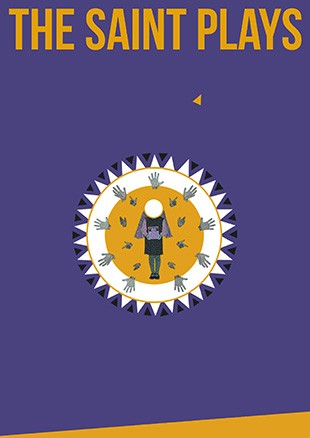Saint Barbara is at the heart of Radio Elephant, a trippy manipulation of time and space realities. A 13-year-old girl, who is kept in a tower by her father, smuggles in a sage named Bob who teaches her to build a radio. The more she learns, the bigger her head grows, causing her to become disfigured with what could actually be elephantiasis. Multiple scenarios are considered as possible conclusions before her father ultimately kills her.
Minaker chose these plays because of the common thread of violence toward girls and the girls’ position as both potential threats and potential victims.
“I was very drawn to the reading,” Minaker says. “I was very excited by it and also very overwhelmed by it. I find it audacious and extremely challenging, and it challenges our notions of what we expect from narrative, what we expect in theatrical storytelling.”
Three actors will manipulate the puppets employed in the telling of these tales — one for the head, one for the arms and one for the legs.
Nearly 50 objects had to be built for The Saint Plays. Third-year theatre-design student Nicolas Ruzza, who created the puppets and other objects for Pain, says the experience was unlike anything he had ever done before.
“It was a little bit daunting when I was given this position on this show and told I had to design puppets,” he says.
Ruzza struggled to conceptualize the representation of the story and its characters, as well as the violence, through puppetry. Minaker, a seasoned puppeteer who has worked on many experimental projects, helped show him the way.
“Clea was really encouraging and motivating in helping me find my access into the story,” Ruzza says.
Minaker developed a passion for puppetry nearly 15 years ago, and has worked with musical acts like Feist and Kid Koala to produce live shadow and video-based puppetry during their performances.
“I was initially drawn to it from the perspective of somebody who was already quite passionate about theatre in general, but I recognized in puppetry an extra level of intrigue and theatricality and possibility for the object to mediate between the performer and the audience,” Minaker says. “Everybody is participating in the creation of the illusion. It’s a very engaged form of theatre and storytelling.”
She says working with Concordia theatre students has been an engaging process for the infectious nature of their excitement, idealism and willingness to try new things.
Most students don’t get the opportunity to take on a contemporary playwright’s work, let alone meet and engage with the writer. Ehn, however, will be at Concordia on February 18 for a talk coinciding with the opening of the production.
“The students and I are very excited, honoured and humbled to be able to exchange with an author whose work has really challenged us in so many ways,” Minaker says. “It’s not easy writing, and we hope we’ve done it justice.”
Erik Ehn will speak about his most recent commemorative cycle of 17 plays, Soulographie: Our Genocides, at Concordia on February 18, at 5:30 p.m., in the John Molson School of Business building’s theatre studio (MB 7.270).
The Saint Plays performances will take place at the Cazalet Theatre on the Loyola campus (7141 Sherbrooke St. W.) on Feb. 18–21 at 7 p.m. and 9 p.m., as well as Feb. 21–22 at 1 p.m. and 3 p.m. Admission is $10 full price and $5 for students and seniors. To reserve tickets, email tickets.finearts@concordia.ca.


 Director Clea Minaker: “The students and I are very excited, honoured and humbled to be able to exchange with an author [Erick Ehn, pictured right] whose work has really challenged us in so many ways.”
Director Clea Minaker: “The students and I are very excited, honoured and humbled to be able to exchange with an author [Erick Ehn, pictured right] whose work has really challenged us in so many ways.”
